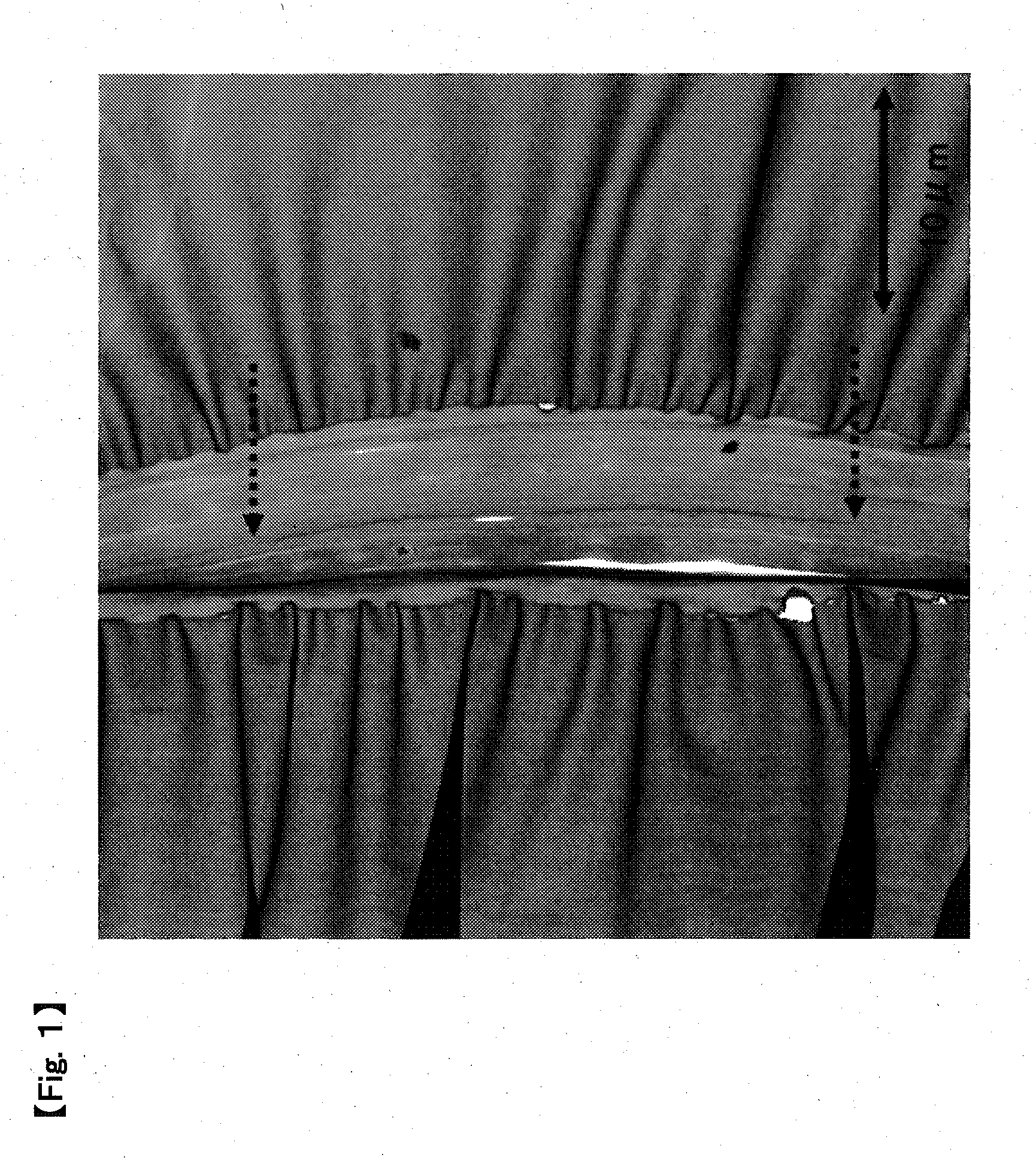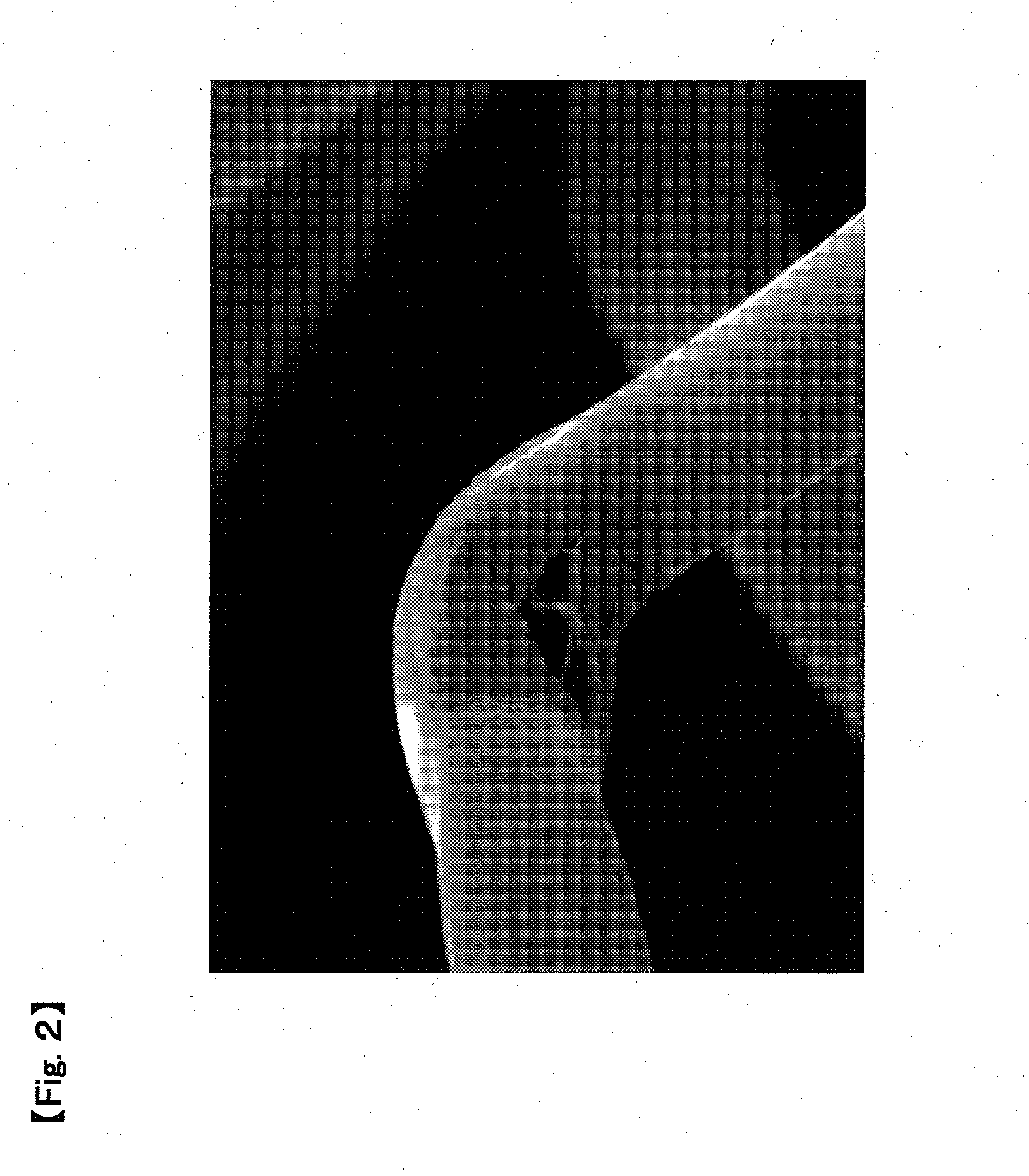Conjugated fiber, base body for artificial leather, and artificial leather
- Summary
- Abstract
- Description
- Claims
- Application Information
AI Technical Summary
Benefits of technology
Problems solved by technology
Method used
Image
Examples
example 1
Staple Fiber
(Polymer of the Island Component)
[0117]A polyethylene terephthalate (PET) having a melting point of 260° C. and a MFR of 46.5 was used for the polymer of the island component.
(Polymer of the sea component)
[0118]A PET (Copolymerized PET 1) having 8% by mole of 5-sodium sulfoisophthalate copolymerized therewith having a melting point of 240° C. and a MFR of 100 was used for the polymer of the sea component.
(Spinning and Stretching)
[0119]By using the polymers of the sea component and the island component as described above, 2.0% by weight of polyethylene glycol having a molecular weight of 20,000 was melt-blended with the sea component, and the melt spinning was conducted under the conditions including a spinning temperature of 285° C., an island / sea weight ratio of 55 / 45, an ejection rate of 1.8 g / minute per hole, and a spinning speed of 1200 m / minute by using a 16 islands / hole islands-in-the-sea type conjugated spinning nozzle.
[0120]Next, the extrudate was stretched in tw...
example 2
Staple Fiber
(Polymer of the Island Component and Polymer of the Sea Component)
[0127]The polymers used were the same as those used in Example 1.
(Spinning and Stretching)
[0128]The procedure of Example 1 was repeated except that the polymers of the sea component and the island component as described above were used, and 5.0% by weight of polyethylene glycol having a molecular weight of 20,000 was melt-blended. The resulting conjugated fiber had a single fiber fineness of 4.5 dtex, a crimp retention index of 6.1, and a shrinkage rate at 98° C. of 19.1%. This conjugated fiber was cut at a fiber length of 51 mm to obtain a staple fiber for an islands-in-the-sea conjugated fiber. When the cross-section of the conjugated fiber was observed with a TEM, the polyethylene glycol appeared as streaks extending in the longitudinal direction, and the maximum length was 59 μm. 10 or more buckled parts with the crack having a length of 15 μm or more were observed in the buckled parts formed by crimpi...
example 3
Staple Fiber
(Polymer of the Island Component and Polymer of the Sea Component)
[0131]The polymers used were the same as those used in Example 1.
(Spinning and Stretching)
[0132]The procedure of Example 1 was repeated except that the polymers of the sea component and the island component as described above were used, and 10.0% by weight of polyethylene glycol having a molecular weight of 20,000 was melt-blended. The resulting conjugated fiber had a single fiber fineness of 4.5 dtex, a crimp retention index of 5.0, and a shrinkage rate at 98° C. of 18.8%. This conjugated fiber was cut at a fiber length of 51 mm to obtain a staple fiber for an islands-in-the-sea conjugated fiber. When the cross-section of the conjugated fiber was observed with a TEM, the polyethylene glycol appeared as streaks extending in the longitudinal direction, and the maximum length was 112 μm. 10 or more buckled parts with the crack having a length of 15 μm or more were observed in the buckled parts formed by crim...
PUM
| Property | Measurement | Unit |
|---|---|---|
| Temperature | aaaaa | aaaaa |
| Percent by mass | aaaaa | aaaaa |
| Shrinkage | aaaaa | aaaaa |
Abstract
Description
Claims
Application Information
 Login to View More
Login to View More - R&D
- Intellectual Property
- Life Sciences
- Materials
- Tech Scout
- Unparalleled Data Quality
- Higher Quality Content
- 60% Fewer Hallucinations
Browse by: Latest US Patents, China's latest patents, Technical Efficacy Thesaurus, Application Domain, Technology Topic, Popular Technical Reports.
© 2025 PatSnap. All rights reserved.Legal|Privacy policy|Modern Slavery Act Transparency Statement|Sitemap|About US| Contact US: help@patsnap.com


